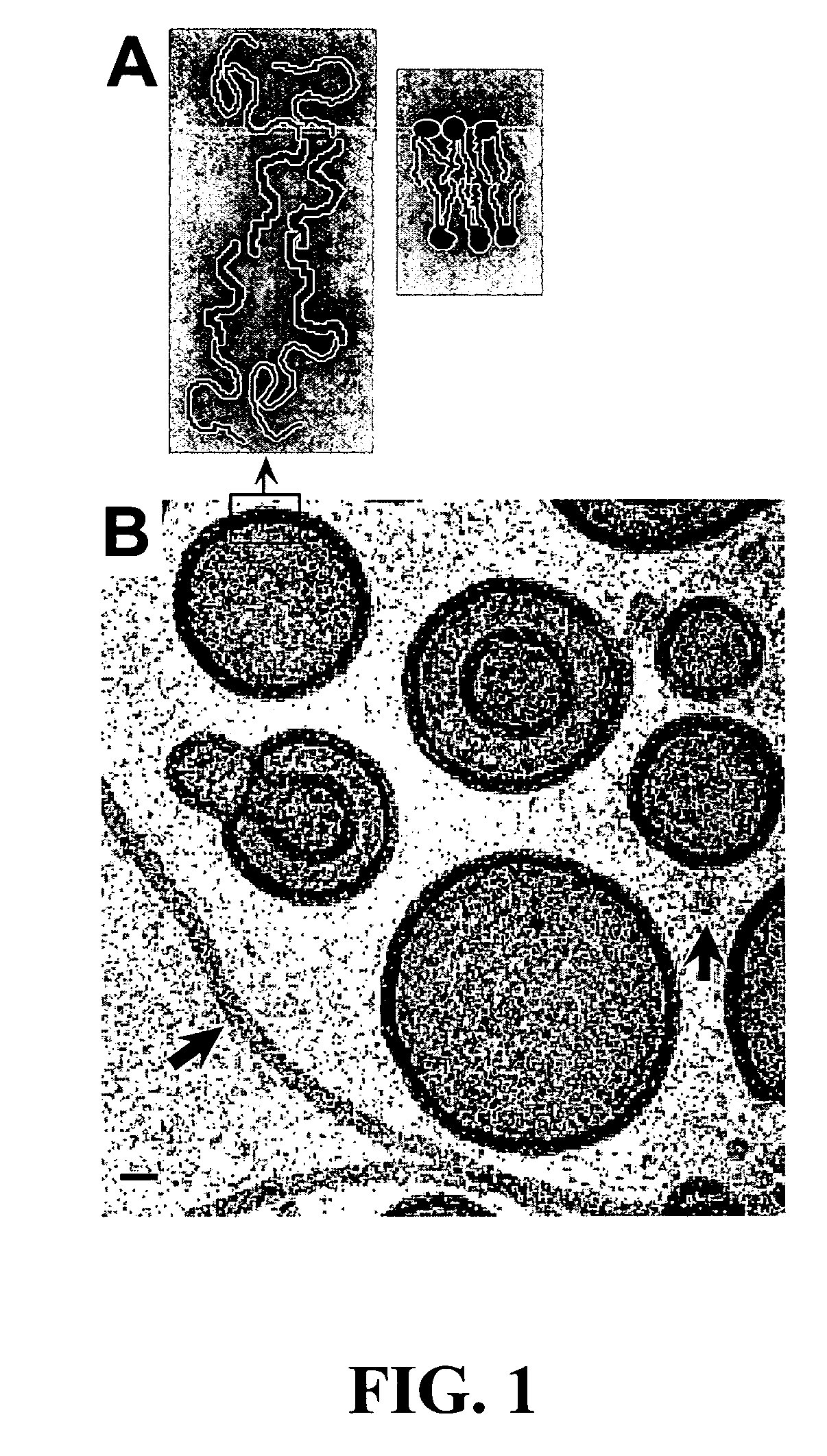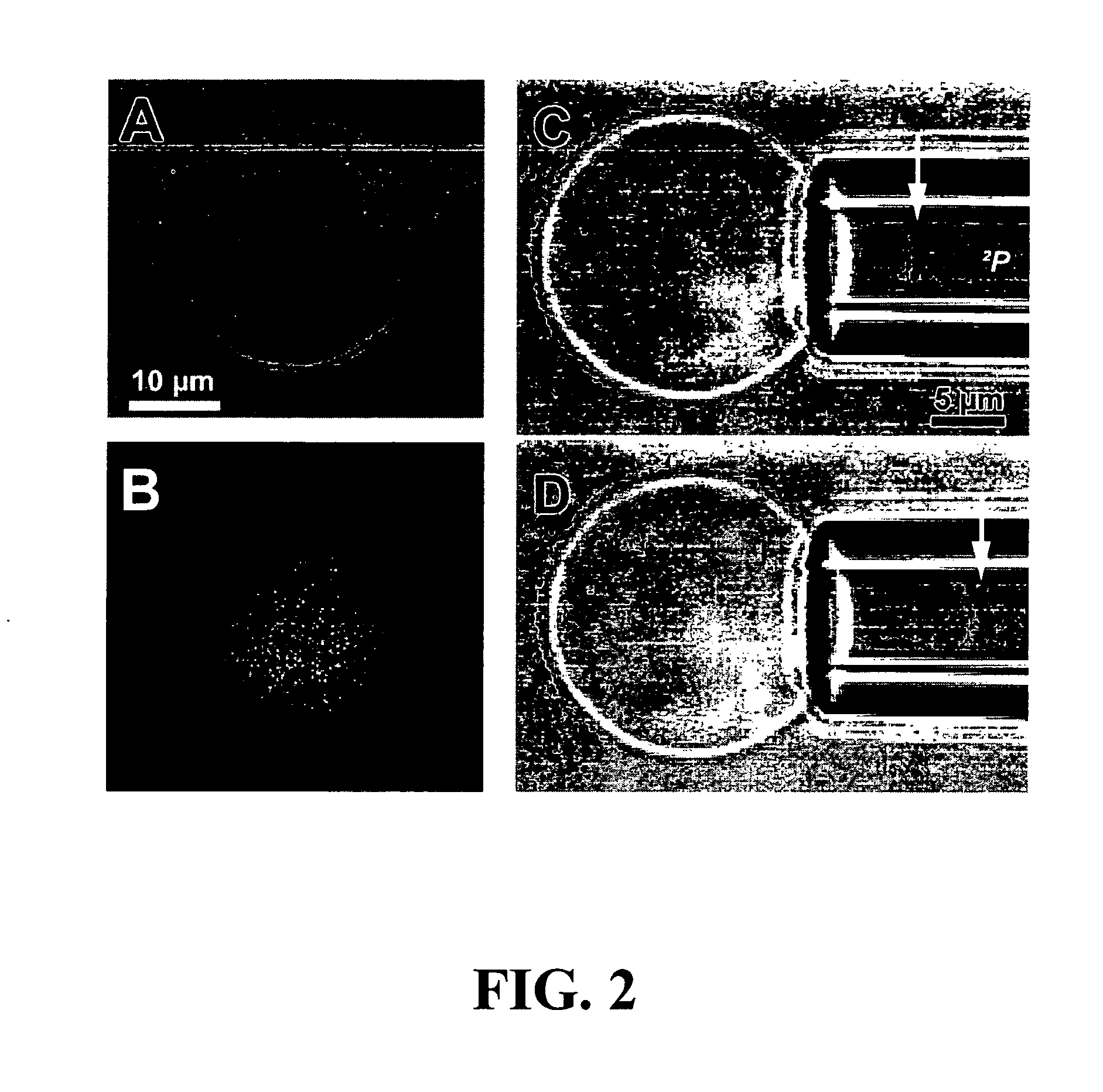Polymersomes and related encapsulating membranes
a vesicles and lipid technology, applied in the field of polymersomes and related encapsulating membranes, can solve the problems of difficult to determine the full extent of cross-linking with cross-linkable lipids, no fully cross-linked lipid vesicle larger than several hundred nanometers has been reported, and achieves the effect of convenient measuremen
- Summary
- Abstract
- Description
- Claims
- Application Information
AI Technical Summary
Benefits of technology
Problems solved by technology
Method used
Image
Examples
example 1
Polymersomes from Amphiphilic Diblock Copolymers
[0135]Membranes assembled from a high molecular weight, synthetic analog (a super-amphiphile) are exemplified by a linear diblock copolymer EO40-EE37. This neutral, synthetic polymer has a mean number-average molecular weight of about 3900 g / mol mean, and a contour length ˜23 nm, which is about 10 times that of a typical phospholipid acyl chain (FIG. 1A). The polydispersity measure, Mw / Mn, was 1.10, where Mw and Mn are the weight-average and number-average molecular weights, respectively. The PEO volume fraction was fEO=0.39, per TABLE 1.
[0136]Adapting the electroformation methods of Angelova et al., 1992, a thin film (about 10 nm to 300 nm) was prepared. Giant vesicles attached to the film-coated electrode were visible after 15 to 60 min. These were dissociated from the electrodes by lowering the frequency to 3 to 5 Hz for at least 15 min and by removing the solution from the chamber into a syringe. The polymersomes were stable for at...
example 2
Crosslinked Polymersomes
[0154]Given the flexibility of copolymer chemistry, the stealth character as well as the cell stability can be mimicked with amphiphilic diblock copolymers that have a hydrophilic fraction comprising PEO, and a hydrophobic fraction which can be covalently cross-linked into a network. One example of a diblock copolymer having such properties, along with the capability of forming several morphologically different phases, is polyethylene oxide-polybutadiene (PEO—PBD).
[0155]EO26-BD46, spontaneously forms giant vesicles as well as smaller vesicles in aqueous solutions without the need of any co-solvent. Cross-linkable unilamellar vesicles were fabricated. The formed vesicles were cross-linked by free radicals generated with a of initiating K2S2O8 and a redox couple Na2S2O5 / FeSO4.7H2O as described above. When the osmolarity of the cross-linking reagents was kept the same as that of the vesicle solution, neither addition of the cross-linking reagents nor the cross-l...
example 3
Polymersomes from Amphiphilic Triblock and Multi-Block Copolymers
[0164]Multi-block copolymers offer an alternative approach to modifying the properties of the polymersome. Insertion of a middle B block in a triblock copolymer permits modification of permeability and mechanical characteristics of the polymersome without chemical cross-linking. For example, if the B and C blocks are strongly hydrophobic, yet mutually incompatible, and the A block is water miscible, two segregated layers will form within the core of the membrane. This configuration of interfaces (internal B—C and external B-hydrated A) offers control of the spontaneous curvature of the membrane among other features such as height-localized cross-linking. Thus, vesicle size will depend, in part, on block copolymer composition. Of course, as noted above, the physical properties of the ABC polymersome will reflect a combination of the B, C and hydrated A mechanical behaviors. An example of such a triblock copolymer, which...
PUM
| Property | Measurement | Unit |
|---|---|---|
| thick | aaaaa | aaaaa |
| diameter | aaaaa | aaaaa |
| vesicle diameter | aaaaa | aaaaa |
Abstract
Description
Claims
Application Information
 Login to View More
Login to View More - R&D
- Intellectual Property
- Life Sciences
- Materials
- Tech Scout
- Unparalleled Data Quality
- Higher Quality Content
- 60% Fewer Hallucinations
Browse by: Latest US Patents, China's latest patents, Technical Efficacy Thesaurus, Application Domain, Technology Topic, Popular Technical Reports.
© 2025 PatSnap. All rights reserved.Legal|Privacy policy|Modern Slavery Act Transparency Statement|Sitemap|About US| Contact US: help@patsnap.com



